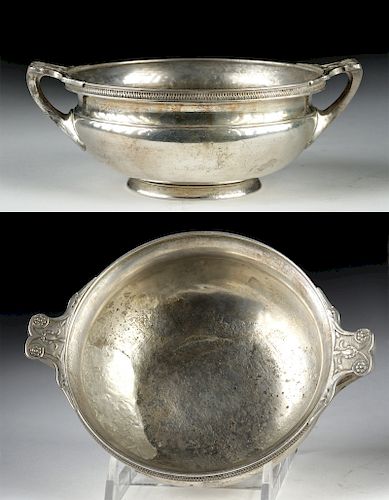Published Roman Silver Skyphos with Handles - 261.1 g
Lot 45b
About Seller
Artemis Fine Arts
686 S Taylor Ave, Ste 106
Louisville, CO 80027
United States
Selling antiquities, ancient and ethnographic art online since 1993, Artemis Gallery specializes in Classical Antiquities (Egyptian, Greek, Roman, Near Eastern), Asian, Pre-Columbian, African / Tribal / Oceanographic art. Our extensive inventory includes pottery, stone, metal, wood, glass and textil...Read more
Estimate:
$18,000 - $25,000
Absentee vs Live bid
Two ways to bid:
- Leave a max absentee bid and the platform will bid on your behalf up to your maximum bid during the live auction.
- Bid live during the auction and your bids will be submitted real-time to the auctioneer.
Bid Increments
| Price | Bid Increment |
|---|---|
| $0 | $25 |
| $300 | $50 |
| $1,000 | $100 |
| $2,000 | $250 |
| $5,000 | $500 |
| $10,000 | $1,000 |
| $20,000 | $2,500 |
| $50,000 | $5,000 |
| $100,000 | $10,000 |
| $200,000 | $20,000 |
About Auction
By Artemis Fine Arts
May 22, 2019
Set Reminder
2019-05-22 10:00:00
2019-05-22 10:00:00
America/New_York
Bidsquare
Bidsquare : Exceptional Day 1: Antiquities Asian Fine Art
https://www.bidsquare.com/auctions/artemis-gallery/exceptional-day-1-antiquities-asian-fine-art-4129
Day 1 of an important 2-day auction featuring exceptional art from around the world - Egyptian, Greek, Etruscan, Roman, Viking, Russian, Near Eastern; Asian Art from China, Japan, Thailand, Vietnam, Burma, India; Fine Art from the 17th century to present. Artemis Fine Arts info@artemisgallery.com
Day 1 of an important 2-day auction featuring exceptional art from around the world - Egyptian, Greek, Etruscan, Roman, Viking, Russian, Near Eastern; Asian Art from China, Japan, Thailand, Vietnam, Burma, India; Fine Art from the 17th century to present. Artemis Fine Arts info@artemisgallery.com
- Lot Description
Roman, Imperial Period, ca. 1st century CE. A very fine grade silver skyphos (95% silver) with upraised handles. The vessel's body is carinated at the shoulder, presents a concave neck and flat rim that is decorated with an impressed pattern framed by everted borders, and sits upon a concave base with concentric circles and a possible makers mark on the base. The handles are curvaceous in form and impressively decorated with balanced, symmetrical floral blossoms and foliage motifs adorning the top flat areas; their profiles are bifurcated and present what look like makers marks at the lower ends. Cups like this example were used for drinking wine or imbibing other alcoholic substances. The fact that it is made from silver suggests it was created for an individual of wealth and status who could easily afford the price of finer material like silver. Size: 5.75" W handlespan x 2.125" H (14.6 cm x 5.4 cm)
Exhibited and published in catalogue for "Dressed to Kill in Love and War: Splendor in the Ancient World" (February 1 - March 31, 2019 - Academy Museum, Easton, Maryland, USA, fig. 33, pp. 4 and 10)
For a stylistically-similar example, please see The Metropolitan Museum of Art, accession number 20.49.3: https://www.metmuseum.org/art/collection/search/250915
Provenance: private East Coast, USA collection; Exhibited and published in catalogue for "Dressed to Kill in Love and War: Splendor in the Ancient World" (February 1 - March 31, 2019 - Academy Museum, Easton, Maryland, USA, fig. 33, pp. 4 and 10); ex-Madame Frances Artuner collection, Belgium, acquired in the 1960s
All items legal to buy/sell under U.S. Statute covering cultural patrimony Code 2600, CHAPTER 14, and are guaranteed to be as described or your money back.
A Certificate of Authenticity will accompany all winning bids.
We ship worldwide and handle all shipping in-house for your convenience.
#146252Body professionally repaired from a few large pieces with areas of restoration along break lines. Expected surface wear with scuffs and abrasions and light softening/scratches to some stamped motifs and possible makers mark on base. Fine patina throughout.Condition
- Shipping Info
-
All shipping is handled in-house for your convenience. Your invoice from Artemis Gallery will include shipping calculation instructions. If in doubt, please inquire BEFORE bidding for estimated shipping costs for individual items.
-
- Buyer's Premium



 EUR
EUR CAD
CAD AUD
AUD GBP
GBP MXN
MXN HKD
HKD CNY
CNY MYR
MYR SEK
SEK SGD
SGD CHF
CHF THB
THB
















